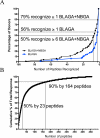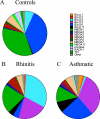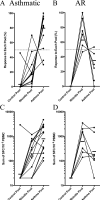Different Bla-g T cell antigens dominate responses in asthma versus rhinitis subjects
- PMID: 26414909
- PMCID: PMC4654660
- DOI: 10.1111/cea.12643
Different Bla-g T cell antigens dominate responses in asthma versus rhinitis subjects
Abstract
Background and objective: The allergenicity of several German cockroach (Bla-g) antigens at the level of IgE responses is well established. However, less is known about the specificity of CD4+ TH responses, and whether differences exist in associated magnitude or cytokine profiles as a function of disease severity.
Methods: Proteomic and transcriptomic techniques were used to identify novel antigens recognized by allergen-specific T cells. To characterize different TH functionalities of allergen-specific T cells, ELISPOT assays with sets of overlapping peptides covering the sequences of known allergens and novel antigens were employed to measure release of IL-5, IFNγ, IL-10, IL-17 and IL-21.
Results: Using these techniques, we characterized TH responses in a cohort of adult Bla-g-sensitized subjects, either with (n = 55) or without (n = 17) asthma, and nonsensitized controls (n = 20). T cell responses were detected for ten known Bla-g allergens and an additional ten novel Bla-g antigens, representing in total a 5-fold increase in the number of antigens demonstrated to be targeted by allergen-specific T cells. Responses of sensitized individuals regardless of asthma status were predominantly TH 2, but higher in patients with diagnosed asthma. In asthmatic subjects, Bla-g 5, 9 and 11 were immunodominant, while, in contrast, nonasthmatic-sensitized subjects responded mostly to Bla-g 5 and 4 and the novel antigen NBGA5.
Conclusions: Asthmatic and nonasthmatic cockroach-sensitized individuals exhibit similar TH 2-polarized responses. Compared with nonasthmatics, however, asthmatic individuals have responses of higher magnitude and different allergen specificity.
Keywords: CD4+ T cell; asthma; cockroach allergy; epitope.
© 2015 John Wiley & Sons Ltd.
Figures







References
-
- Camelo-Nunes IC, Solé D. Cockroach allergy: risk factor for asthma severity. J Pediatr (Rio J) 2006 Sep;82(5):398–9–authorreply399–400. - PubMed
-
- Rosenstreich DL, Eggleston P, Kattan M, Baker D, Slavin RG, Gergen P, et al. The role of cockroach allergy and exposure to cockroach allergen in causing morbidity among inner-city children with asthma. N Engl J Med. 1997 May 8;336(19):1356–63. - PubMed
-
- Busse PJ, Wang JJ, Halm EA. Allergen sensitization evaluation and allergen avoidance education in an inner-city adult cohort with persistent asthma. J Allergy Clin Immunol. 2005 Jul;116(1):146–52. - PubMed
Publication types
MeSH terms
Substances
Grants and funding
LinkOut - more resources
Full Text Sources
Other Literature Sources
Medical
Molecular Biology Databases
Research Materials

